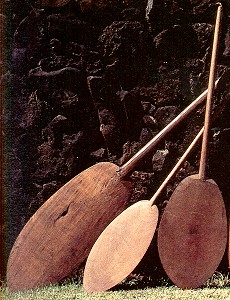 |
surfresearch.com.au
ancient hawaiian surfboards: #1 |
| home | catalogue | history | references | appendix |
|
1.
THE FIRST REPORTS OF POLYNESIAN SURFRIDING
The earliest written
reports of Polynesian surfriding activity were initially in Tahiti by members
of James Cook's Pacific expeditions, before his visits to the Hawaiian
Islands in 1778 and 1779.
"Cook's journals are the starting point for all studies of the history and culture of four major island groups in Polynesia (Society, Tonga, New Zealand and Hawai'i) and of eastern Australia, Vanuatu (New Hebrides) and New Caledonia." (1)
1.1 Joseph Banks, in company with Cook and Solander, reported in his journal, 29th May 1769:
"In the midst
of these breakers 10 or 12 Indians were swimming who whenever a surf broke
near
them divd
under it with infinite ease, rising up on the other side; but their chief
amusement was
carried on
by the stern of an old canoe, with this before them they swam out as far
as the
outermost
breach, then one or two would get into it and opposing the blunt end to
the
breaking wave
were hurried in with incredible swiftness." (2)
This first report
corresponds to a description of basic surfriding activity- the paddle out,
the take-off and the ride.
In particular it
notes the use of a craft to increase surf riding performance, albeit "the
stern of an old canoe".
Although not detailed
in any of the available literature, the recycling of damaged canoes into
smaller craft may have been common practice in the formative era of ancient
surfboard building.
1.2 On Cook's third Pacific voyage, a report of Tahitian canoe surfing was recorded by William Anderson, Surgeon 'Resolution' in August-September 1777.
"He went out
from the shore till he was near the place where the swell begins to take
its rise; and,
watching its
first motion very attentively, paddled before it with great quickness,
till (it) had
acquired sufficient
force to carry his canoe before it without passing underneath.
He sat motionless,
and was carried along at the same swift rate as the wave, till it landed
him on
the beach.
Then he started
out ... and went in search of another swell.
I could not
help concluding that this man felt the most supreme pleasure while his
was driven so fast
and smoothly
by the sea." (3, 4)
1.3 About the same time, another member of Cook's crew, William Bligh, observed Tahitian surfriders using another rudimentary craft.
"The general
plan of this diversion is for a number of them to advance with their paddles
to where the sea begins to break and, placing the broad part under the
belly, holding the other end with their arms extended full length, they
turn themselves to the surge and balancing themselves on the paddles are
carried to the shore with the greatest rapidity." (5)
| This report, echoing
Banks', notes the use of a craft to increase surf riding performance, in
this case laying on the blade of a canoe paddle with the handle extended
forward.
Similarly, the recycling of damaged paddles into surf craft may have been common practice in ancient surfboard building. Consider the image
right,
Note that the paddles were shaped from on piece of timber and a broken shaft would render the paddle unusable. |
 |
2.
Banks, Joseph: The Endeavour Journal of Joseph Banks 1768 - 1771
Edited by J. C.
Beaglehole
The Trustees of
the Public Library of New South Wales in Association with Angus and Robertson
89 Castlereagh Street,
Sydney.
First published
February 1962. Second Edition 1963.
Two Volumes. Volume
1, page 283. (1963)
3.
Quoted in Warshaw, Matt: The Encyclopedia of Surfing
Viking
Penguin Books Australia
Pty Ltd
250 Camberwell Road
Camberwell, Victoria
3124, Australia. 2004. Pages 134 - 135.
Warshaw contributes
the quote to James Cook, as does Dela Vega (2004) who notes
"In
(Cook,
1784) Vol. II, Chapter 9, 1777, Capt. Cook describes canoe surfing in
Tahiti."Dela
Vega, Timothy T. (editor): 200 Years of Surfing Literature - An
Annoted Bibliography
Published
by Timothy T. Dela Vega.
Produced in
Hanapepe, Kaui, Hawaii. 2004 (ed, 2004), page 15.
For the full Cook
(1784) reference, see below.
In a personal email,
July 2006,Patrick Moser, Drury University, noted
"the famous description
of Tahitian canoe riding by William Anderson (not James Cook) on Cook's
third voyage"
Sincere thanks to
Patrick Moser for his substantial contribution to this subject.
4.
All
reproduced text is in bold italics.
For screen clarity,
the reproduced text and my own work has been adjusted to my standard online
format, that is paragraphs are indicated by a spaced line (replacing indentation)
and each sentence takes a new line.
5.
Quoted in McGinness, Laurie. Photographs by Crawford, Peter: Wildwater
- The Surfriding Way of Life
Jack Pollard Publishing
Pty Ltd. Rigby Ltd Sydney 1977. page 1.
Awaiting confirmation
of the full reference.
6.
Holmes, Tommy: The Hawaiian Canoe - Second Edition
Editions Limited,
PO Box 10558 Honolulu, Hawaii 96816.
First Edition 1981.
Second Edition 1993. Second Printing 1996. page 59.
7.
Holmes
(1993),
op. cit. pages 59-61.
Holmes devotes a
(fully referenced) chapter to paddles, pages 58 to 63.
The second edition
adds a further chapter, pages 203 to 205.

| home | catalogue | history | references | appendix |